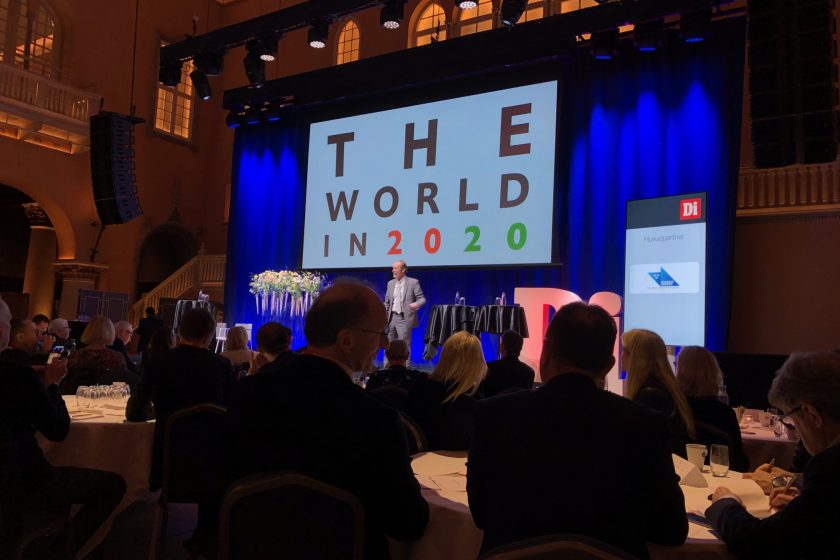Yesterday, the Swedish business magazine Dagens Industri presented the Swedish version of The Economist’s report on The World in 2020, and arranged a future-focused day with leading representatives from the business sector, research and tech developers as well as the Swedish government. Together, they discussed the mega trends shaping the world ahead such as America’s presidential election, the next stage of the Brexit saga, the US-China trade war, technological excitements from self-driving cars to Mars rovers and AI used for the greater good in health care, climate change, immigration, labor competence challenges, fake news and cognitive bias in social media, and how the trends will affect the Swedish economy and society at large.
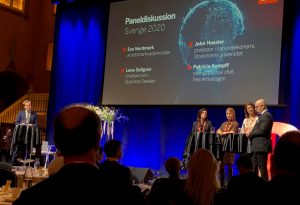 It was inter alia mentioned that the number one topic for the business sector this year was legal certainty and the problems with violence and increasing gaps in the society, as compared to previous years where the main topic for decades has always been a tax-related one. Since the stability and legal certainty in Sweden has been one of the main aspects making Sweden attractive for investments historically, the current developments could potentially have quite a large impact ahead.
It was inter alia mentioned that the number one topic for the business sector this year was legal certainty and the problems with violence and increasing gaps in the society, as compared to previous years where the main topic for decades has always been a tax-related one. Since the stability and legal certainty in Sweden has been one of the main aspects making Sweden attractive for investments historically, the current developments could potentially have quite a large impact ahead.
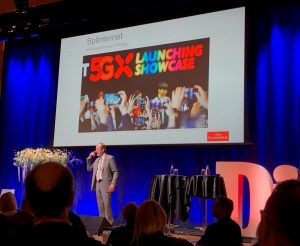 From a tech perspective, Alasdair Ross, Countries Editor, The Economist, predicted that 2020 would be the key year for the Internet of Things. This concept has been floating around for a while, but will now reach a combination of number of items with sensors (over 200 billion connected devices) and fast communication via 5G that will make the connectedness of everything one of the world’s largest industries.
From a tech perspective, Alasdair Ross, Countries Editor, The Economist, predicted that 2020 would be the key year for the Internet of Things. This concept has been floating around for a while, but will now reach a combination of number of items with sensors (over 200 billion connected devices) and fast communication via 5G that will make the connectedness of everything one of the world’s largest industries.
(On a side note, McKinsey included the IoT as one of the ten truly disruptive technologies that will be adding several tens of trillions of dollars to the global economy by 2025 in the white paper Ten IT-enabled business trends for the decade ahead. By just this estimate, for revenue opportunities alone it’s probably vital that organizations consider embracing IoT early and broadly in any untapped spaces, even though one might say it’s nothing more than a convergence of the top pre-existing trends of smart mobility, cloud, and big data.)
The main obstacle for the IoT development is the fear of security threats based on the fact that most 5G solutions are developed by China (Huawei). From a Swedish perspective though, this means that Ericsson has a huge possibility to take market positions, as a more trustworthy provider.
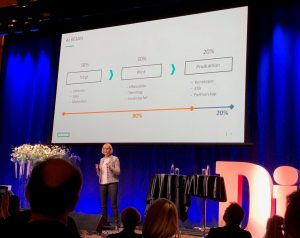 Anna Granö, CEO, HPE, then held a very interesting presentation about the impact of AI on the society. She predicted that during 2020, the development pace for AI solutions will double and that 50% of all IT projects will involve AI. Already today, AI is a big part of our everyday life. For example, when parking garages uses automated systems to open the gates and charge the owner by scanning the license plates, at hospitals when AI solutions are used to identify fractures or spot tumours etc, but the main reason that it has not yet been more widely implemented is the time and effort needed to go from a pilot to a scalable product. As Anna Granö pointed out, one of the biggest challenges is to develop methods and processes for learning that are efficient and scalable. It is also a common misconception that AI solutions once launched will keep learning by themselves. Instead, we should think of AI solutions more like Tamagotchis, where the models must constantly be trained, nurtured and developed. Another main issue is the enormous need for computer power to handle the data and computations.
Anna Granö, CEO, HPE, then held a very interesting presentation about the impact of AI on the society. She predicted that during 2020, the development pace for AI solutions will double and that 50% of all IT projects will involve AI. Already today, AI is a big part of our everyday life. For example, when parking garages uses automated systems to open the gates and charge the owner by scanning the license plates, at hospitals when AI solutions are used to identify fractures or spot tumours etc, but the main reason that it has not yet been more widely implemented is the time and effort needed to go from a pilot to a scalable product. As Anna Granö pointed out, one of the biggest challenges is to develop methods and processes for learning that are efficient and scalable. It is also a common misconception that AI solutions once launched will keep learning by themselves. Instead, we should think of AI solutions more like Tamagotchis, where the models must constantly be trained, nurtured and developed. Another main issue is the enormous need for computer power to handle the data and computations.
(On a side note, in a BBC article just a few days ago, it was argued that we might be “on the cusp of an AI Winter”, as there are signs that the AI hype might be about to start cooling off. The term AI became a real buzzword through the last decade, with companies of all shapes and sizes latching onto the term, often for marketing purposes. Similarly to Anna Granö, it’s pointed out in the article that one of the biggest challenges is to develop methods that are much more efficient in terms of the data and compute power required to learn to solve a problem well. In the past decade, we’ve seen impressive advances made by increasing the scale of data and computation available, but that’s not appropriate or scalable for every problem. The field has come a very long way in the past decade, but we are very much aware that we still have far to go in scientific and technological advances to make machines truly intelligent.)
It was a great inspiration though to see the film that Anna Granö showed about how the Mercedes F1 Team uses AI to improve pre-event simulation time and trackside analytics. With AI, the pre-event simulation run times has dropped from three to four days down to just under a day, enabling reiteration on a daily basis, and is one of the reasons why Lewis Hamilton is a six-time World Champion.
https://www.youtube.com/watch?v=Ox3Y1tcK9uI
The solution is now being used to develop self-driving cars, which Håkan Samuelsson, CEO, Volvo Cars, in his presentation predicted would be a reality within just a couple of years, as would car subscription services.
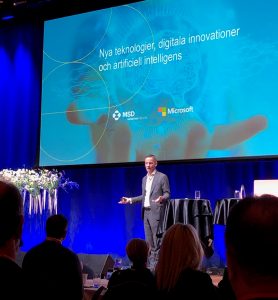 Other interesting news was the new strategic partnership between MSD and Microsoft to create new possibilities for health care providers and patients by the use of artificial intelligence. For example to support early diagnosis for lung cancer. Jakob Tellgren, VP Nordics and Baltics, MSD, explained how the new technological advances and the enormous amounts of data makes it impossible for individual persons or corporations to keep up with all new research findings, analysis of patient data etc. The only way forward is to cooperate and combine technology and human insights to enhance and digitalise all parts of the value chain. Therefore, MSD wishes to see life science and health in a broader perspective, where access to data and modern tech solutions can be combined to benefit all, including patients, medical practitioners, the research community, and decision makers. Mathias Ekman, Director Industry Solutions at Microsoft Western Europe, added that the Nordics is an ideal region with the public health sector, the respect for personal integrity and legal certainty. Solutions developed here will have it far easier to gain trust globally than similar solutions developed in China.
Other interesting news was the new strategic partnership between MSD and Microsoft to create new possibilities for health care providers and patients by the use of artificial intelligence. For example to support early diagnosis for lung cancer. Jakob Tellgren, VP Nordics and Baltics, MSD, explained how the new technological advances and the enormous amounts of data makes it impossible for individual persons or corporations to keep up with all new research findings, analysis of patient data etc. The only way forward is to cooperate and combine technology and human insights to enhance and digitalise all parts of the value chain. Therefore, MSD wishes to see life science and health in a broader perspective, where access to data and modern tech solutions can be combined to benefit all, including patients, medical practitioners, the research community, and decision makers. Mathias Ekman, Director Industry Solutions at Microsoft Western Europe, added that the Nordics is an ideal region with the public health sector, the respect for personal integrity and legal certainty. Solutions developed here will have it far easier to gain trust globally than similar solutions developed in China.
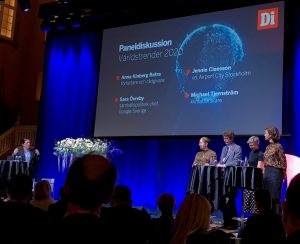 Some other notable mega trends from the very inspiring day was (i) the growing “yold” population (old persons taking opportunity by their greater health, wealth and freedom to behave like kids) and the increasing generation division as today’s youth do not particularly appreciate the world the yolds have created and the problems caused by their lifestyle to be inherited by the next generations, (ii) how the increased competence demands on the labor market in combination with a low technology effect still puts a hold on the predicted disruption and efficiency gains of the digitalization, (iii) how the business sector must take the lead in the climate change adaptions when the politicians are too focused on shortsighted gains and (iv) the “Trumpism” with aggressive debates and personal attacks as well as the increased fact resistance and fake news, but also the counter movement with increased awareness of the importance of trustworthy sources, and the balanced and professional tone in the recent Democratic Party presidential primaries.
Some other notable mega trends from the very inspiring day was (i) the growing “yold” population (old persons taking opportunity by their greater health, wealth and freedom to behave like kids) and the increasing generation division as today’s youth do not particularly appreciate the world the yolds have created and the problems caused by their lifestyle to be inherited by the next generations, (ii) how the increased competence demands on the labor market in combination with a low technology effect still puts a hold on the predicted disruption and efficiency gains of the digitalization, (iii) how the business sector must take the lead in the climate change adaptions when the politicians are too focused on shortsighted gains and (iv) the “Trumpism” with aggressive debates and personal attacks as well as the increased fact resistance and fake news, but also the counter movement with increased awareness of the importance of trustworthy sources, and the balanced and professional tone in the recent Democratic Party presidential primaries.

